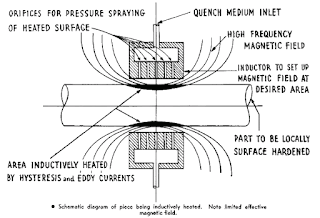One of the benefits of induction
hardening is the ability to selectively apply a surface hardness or case
hardness to steel materials. The case hardness will allow the piece to have
superior wear and strength characteristics at the surface, but allow the interior
of the piece to remain flexible in Induction
Hardening in Faridabad.
Case hardness is defined as the
outer surface that has been made harder than the interior, or core. The term
case depth refers to the depth of the case, or hardened layer of a piece of
material. Case depth is typically measured as “total” or “effective”. The two
terms are sometimes misunderstood, but are different and it is important to
understand those differences.
The term total Case Hardening in Faridabad
refers to the depth of hardness where the hardened layer reaches the same
hardness and properties as the base or core material. Total case depth is
typically measured by sectioning the work piece and polishing and etching with
an acid solution to reveal the depth of the hardened layer. The measurements
can then be taken visually and measured using a calibrated eyepiece or scale to
qualify the total depth.
The term effective case depth
refers to the depth where a hardness measurement drops below a specified point.
The hardness will then continue to decline until the “total” case depth is
reached. The hardness at the effective depth is specified based on the
characteristics required and the hardenabiltiy of the material. For example,
high carbon steel that may have a minimum surface hardness of 60 HRc may call
for an effective case depth of 0.120” at 50 HRc. The method of determining
effective case depth involves sectioning the piece and polishing the surface.
Measurements of the hardness are then taken at regular depth intervals until
the hardness drops to the specified range. This distance from the surface is
then measured to determine the effective depth in Induction Hardening.


